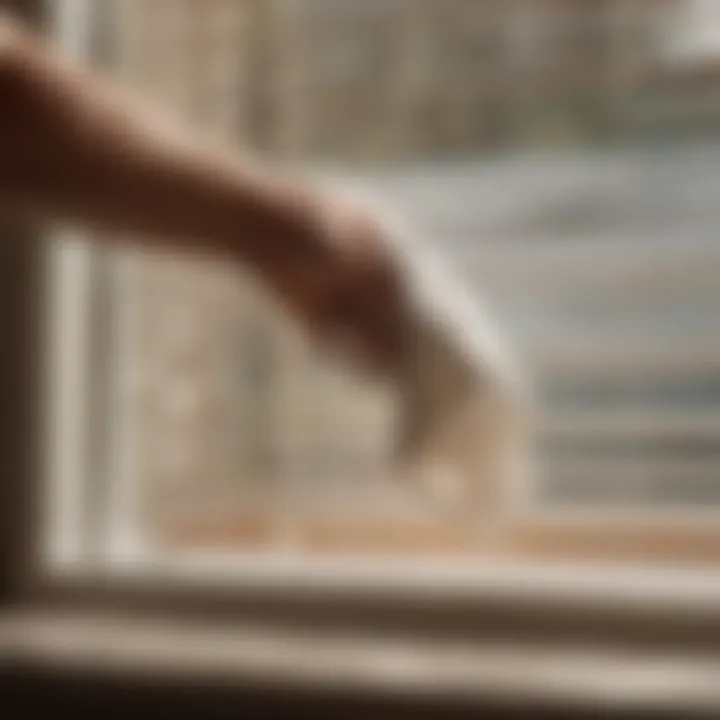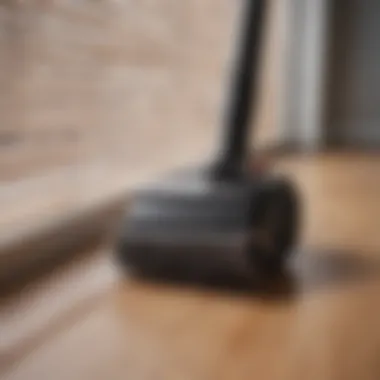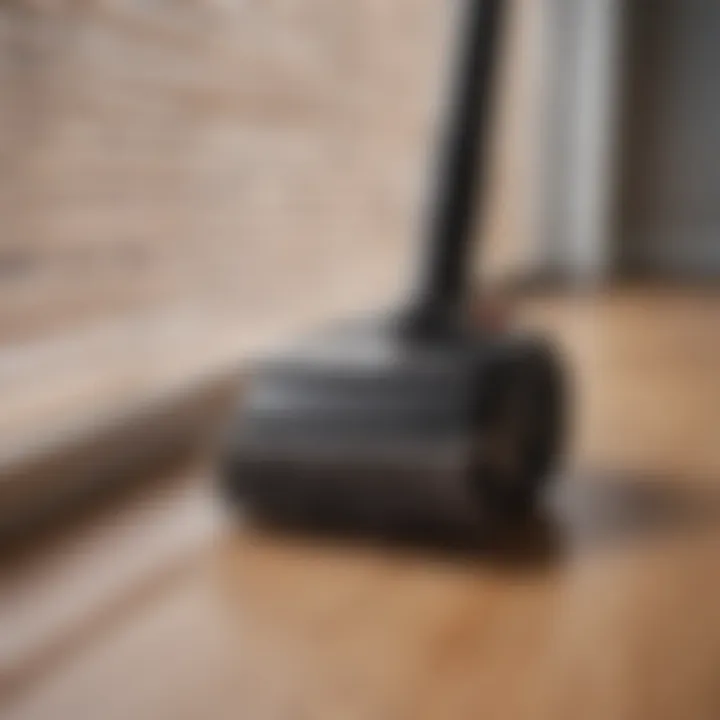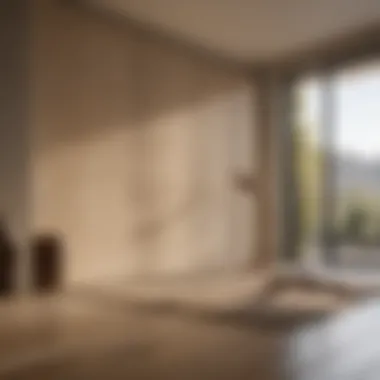Expert Tips for Cleaning Your Blinds Like a Pro at Home


Inspiring Homes
Cleaning your blinds may seem like a mundane task, but it is a crucial aspect of home maintenance. Just like how luxurious properties require constant care and attention to detail to maintain their grandeur, your blinds also need proper cleaning to retain their pristine condition. Whether it's the extravagant mansions with floor-to-ceiling windows or the charming cottages with cozy window treatments, ensuring your blinds are spotless can truly elevate the ambiance of your living space.
Cleaning Methods and Techniques
When it comes to cleaning blinds, various methods and techniques can be employed based on the material and type of blinds you have. From wooden blinds that require gentle dusting to metal or vinyl blinds that can withstand more rigorous cleaning, each material demands specific care. Coordinating the cleaning process with the corresponding architectural style of your home can create a cohesive and harmonious look throughout.
Step-by-Step Cleaning Process
To effectively clean your blinds, start by dusting off any debris using a microfiber cloth or a vacuum cleaner with a brush attachment. For a deeper clean, consider using a solution of mild soap and water or specialized blind-cleaning products. Implementing a systematic approach to cleaning each slat individually can ensure thoroughness and meticulous attention to detail.
Maintenance Tips and Tricks
Maintaining your blinds extends beyond regular cleaning; it involves preventive measures to prolong their lifespan. Utilizing UV protectant sprays for blinds exposed to direct sunlight or investing in quality blinds from the start can significantly reduce the frequency of intensive cleaning. By incorporating these maintenance tips into your routine, you can preserve the beauty and functionality of your blinds for years to come.
Conclusion
Introduction
In the realm of home maintenance, tending to blinds might not always be the first task that comes to mind. However, maintaining clean blinds is crucial not just for aesthetic reasons but for the health and hygiene of your living space. Dust, grime, and allergens tend to accumulate on blinds over time, posing potential health risks and diminishing indoor air quality. Clean blinds not only enhance the visual appeal of your home but also promote a healthier environment for you and your family. By following effective cleaning techniques, you can ensure that your blinds remain fresh, prolonging their lifespan and maintaining a pristine atmosphere in your home.
Understanding the Importance of Clean Blinds
Appreciating the significance of clean blinds extends beyond mere appearance. Dust and dirt buildup on blinds can aggravate allergies and respiratory issues, particularly for individuals sensitive to airborne particles. By regularly cleaning your blinds, you reduce the presence of allergens in your home, fostering a cleaner and safer living space. Moreover, clean blinds contribute to better light control, allowing you to adjust the ambiance of a room and create comfortable living conditions. Understanding the importance of keeping blinds clean not only safeguards your health but also preserves the functionality and longevity of these window treatments.
Materials Needed for Cleaning
When it comes to efficiently conducting a thorough cleaning of your blinds, having the right materials at your disposal is crucial for achieving exemplary results. The materials required for cleaning play a pivotal role in streamlining the entire process with finesse. By selecting high-quality tools and solutions, you ensure that your blinds are not only free of dirt and grime but also maintain their pristine condition for an extended period.
Investing in premium cleaning materials offers numerous advantages. Firstly, superior quality cleaning tools enhance the efficiency of the cleaning process, saving you valuable time and effort. Additionally, using appropriate supplies helps prevent any potential damage to your blinds, ensuring their longevity.
When considering the materials needed for cleaning your blinds, it is essential to take into account the type of blinds you have. Different materials such as wood, aluminum, or fabric blinds necessitate specific cleaning supplies to ensure optimal results. For instance, fabric blinds may require gentle cleaners to avoid discoloration or damage, while wooden blinds might benefit from specialized wood cleaning solutions.
Moreover, the need for materials such as microfiber cloths, gentle brushes, cleaning solutions tailored to the material of your blinds, and protective coverings cannot be understated. Carefully selecting the right materials for cleaning contributes significantly to the overall effectiveness and safety of the cleaning process, guaranteeing that your blinds remain in impeccable condition.


Gather the Essential Supplies
Preparation is key when embarking on the journey of cleaning your blinds. Gathering the essential supplies before initiating the cleaning process streamlines the task, ensuring a seamless and efficient execution. Highlighting the significance of collecting the necessary supplies sets the foundation for a successful cleaning venture, avoiding interruptions and delays that may arise from missing tools.
Begin by assembling all the required supplies in one central location, facilitating easy access during the cleaning process. This practice not only saves time but also prevents unnecessary interruptions that may hinder the thoroughness of the cleaning task.
Essential supplies typically include a microfiber cloth for dusting, a gentle brush attachment for vacuuming, appropriate cleaning solutions for different types of blinds, step ladder for reaching high blinds, and protective coverings to safeguard surrounding areas from potential spills or splashes.
Creating a checklist of essential supplies ensures that no item is overlooked, promoting a smooth and organized cleaning experience. By gathering all the necessary tools beforehand, you set yourself up for success, enabling a hassle-free and effective cleaning session that yields exceptional results.
Preparing Your Workspace
In the realm of blind cleaning, the pinnacle of success rests on the foundation of preparation. Preparing your workspace with meticulous attention pays off exponentially in the cleaning process. It sets the stage for a seamless operation, ensuring both efficiency and effectiveness. By dedicating ample time to prep your workspace, you minimize potential setbacks and maximize the outcome of your cleaning endeavors. This preparatory phase encompasses a series of essential tasks that synergistically contribute to the overall success of the cleaning process.
Clearing the Area Around the Blinds
Clearing the area around the blinds is a fundamental step that often gets underestimated. However, its significance cannot be overstated. Removing obstacles and obstructions around the blinds not only facilitates physical access but also minimizes the risk of accidents or damage during the cleaning process. Clearing the area creates a safe and unobstructed environment for thorough cleaning, ensuring that no corner is left untouched. It allows for better maneuverability and maneuvering ability around the blinds, enabling you to reach even the most inaccessible spots with ease.
Laying Down Protective Coverings
Protective coverings are the unsung heroes of blind cleaning, offering a shield against potential mishaps and unintended consequences. By laying down protective coverings strategically, you safeguard your flooring, furniture, and other surfaces from dirt, water, or cleaning agents. These coverings serve as a protective barrier, preventing stains, scratches, or other damage that could occur during the cleaning process. Choosing the right type of protective coverings based on the specific requirements of your workspace is crucial. Whether it's using plastic sheets, drop cloths, or specialized coverings, ensuring comprehensive coverage is key to a successful cleaning operation.
Basic Cleaning Methods
Cleaning your blinds regularly is essential to maintain a healthy and dust-free environment in your home. Basic cleaning methods play a crucial role in ensuring that your blinds look fresh and well-maintained. By incorporating regular dusting and spot cleaning into your cleaning routine, you can prolong the lifespan of your blinds and preserve their aesthetic appeal. Furthermore, basic cleaning methods help prevent the accumulation of dust, dirt, and stains, promoting a clean and tidy living space.
Regular Dusting Techniques
Regular dusting is key to preventing the buildup of dust and dirt on your blinds. One effective method is using a microfiber cloth, known for its excellent dust-attracting properties. When utilizing a microfiber cloth for dusting, you can easily trap and remove dust particles without causing damage to the blinds' surface. This gentle yet efficient cleaning approach ensures that your blinds remain free of dust, contributing to a healthier indoor atmosphere.
Using a Microfiber Cloth
Using a microfiber cloth for dusting blinds offers several advantages. Its soft texture prevents scratches or marks, making it a safe option for delicate blind materials. The unique structure of microfiber allows it to capture even the smallest dust particles, providing a thorough cleaning result. While using a microfiber cloth, ensure to wipe in gentle, circular motions to effectively remove dust without displacing it into the air.
Vacuuming with a Brush Attachment
Another effective dusting technique is vacuuming blinds with a brush attachment. This method is particularly beneficial for deep cleaning and reaching inaccessible spots. The brush attachment helps agitate and dislodge stubborn dust particles, leaving your blinds fresh and dust-free. However, be cautious when using a vacuum on blinds with delicate fabrics to prevent damage. Vacuuming with a brush attachment complements regular dusting, ensuring a comprehensive cleaning routine for your blinds.


Spot Cleaning Specific Stains
In addition to regular dusting, spot cleaning specific stains is essential for maintaining the appearance of your blinds. Whether dealing with grease spots or water stains, addressing these blemishes promptly can prevent them from becoming permanent marks. By employing targeted cleaning techniques, you can effectively eliminate stains and restore the pristine look of your blinds, enhancing the overall aesthetic of your living space.
Removing Grease Spots
Grease spots pose a common challenge when cleaning blinds, requiring a specialized approach for effective removal. Using grease-cutting solutions or gentle detergents, you can target and dissolve grease stains without causing damage to the blinds' material. Carefully blotting the grease spots with a clean cloth and cleaning solution helps lift the stain, allowing you to achieve a spotless finish.
Treating Water Stains
Water stains can mar the appearance of blinds, necessitating proper treatment to prevent permanent discoloration. To treat water stains, consider using vinegar solution, a natural and effective cleanser. The acidic properties of vinegar help break down mineral deposits present in water stains, restoring the blinds' original color and texture. By treating water stains promptly with vinegar solution, you can revive the look of your blinds and maintain their aesthetic appeal.
Deep Cleaning Methods
Deep cleaning methods are a crucial part of the comprehensive guide on how to clean your blinds at home. This section delves into intricate details on the best practices for ensuring your blinds are thoroughly cleaned. Deep cleaning helps in removing embedded dirt, allergens, and grime that may not be effectively removed through regular cleaning methods.
When it comes to deep cleaning blinds, taking a systematic approach is key. By dismantling the blinds and giving them a thorough cleaning, you can ensure that every nook and cranny is attended to. This method proves highly effective in restoring the blinds to their original pristine condition.
Furthermore, deep cleaning also extends the lifespan of your blinds. By eliminating dirt that can cause wear and tear over time, you can maintain the quality of your blinds for a longer period. Regular deep cleaning also contributes to a healthier indoor environment by reducing the accumulation of dust and allergens.
Taking Down the Blinds for Thorough Cleaning
In the process of deep cleaning your blinds, taking them down for thorough cleaning becomes essential. This allows you to access both sides of the blinds and clean them meticulously. Before removing the blinds, ensure you have a clear workspace and lay down protective coverings to prevent any damage to the blinds or surrounding areas.
Begin by carefully detaching the blinds from their mountings, following the manufacturer's instructions if needed. Once removed, you can proceed to clean each slat individually, using appropriate cleaning solutions and tools. Pay special attention to any stubborn stains or accumulated debris for a comprehensive cleaning result.
After cleaning each slat, ensure they are completely dry before reinstallation. This step ensures that no moisture is trapped within the blinds, preventing mold or mildew growth. Once dry, carefully reinstall the blinds, making sure they are secured properly in place.
Soaking and Washing Blinds
Soaking and washing blinds is a pivotal step in the deep cleaning process. This method involves immersing the blinds in a cleaning solution to dislodge dirt and stains effectively. Begin by preparing a gentle cleaning solution using mild detergent and warm water.
Carefully place the blinds in the solution, ensuring that each slat is fully submerged. Allow the blinds to soak for a sufficient period to loosen dirt and grime. After soaking, gently wipe down each slat with a soft sponge or cloth to remove any remaining residue.
Once cleaned, rinse the blinds with clean water to remove any soapy residue. Allow the blinds to air dry completely before rehanging them. This thorough cleaning method leaves your blinds looking refreshed and free from accumulated dirt or stains.


Using Vinegar Solution for Stubborn Stains
In instances where stubborn stains persist on your blinds, a vinegar solution can prove to be highly effective. Vinegar's acidic properties help break down tough stains without damaging the blinds' material. Create a solution of equal parts water and vinegar in a spray bottle.
Spritz the solution onto the stained areas of the blinds and let it sit for a few minutes to penetrate the stains. Use a clean cloth or brush to gently scrub the affected areas, working the vinegar solution into the stains. Continue this process until the stains begin to lift.
After cleaning, rinse the blinds with water to remove any vinegar residue. Ensure the blinds are completely dry before rehanging them. Utilizing a vinegar solution for stubborn stains ensures a thorough cleaning process without compromising the integrity of your blinds.
Drying and Reinstalling Blinds
When it comes to cleaning blinds at home, proper drying and reinstalling are crucial steps that often get overlooked. In this section, we will delve into the significance of ensuring your blinds are thoroughly dried before rehanging them, as well as the importance of reinstalling them correctly to maintain their functionality and aesthetics.
Ensuring Proper Drying Before Rehanging
Proper drying of blinds is essential to prevent mold, mildew, and water damage. After cleaning, moisture can get trapped in the slats, especially if you have wooden or fabric blinds. To ensure proper drying, it's recommended to hang the blinds outside in a well-ventilated area. This allows air circulation to dry them naturally. Alternatively, you can use a fan or hairdryer on a cool setting to expedite the process. Avoid hanging damp blinds back immediately, as this can lead to unpleasant odors and further dirt buildup.
Reinstalling Blinds Correctly
Reinstalling your blinds correctly is just as important as cleaning them. Improper installation can affect the functionality and look of your blinds. Before reinstalling, inspect the blinds for any damage or missed spots during cleaning. Make sure all the components are in place and functioning correctly. When mounting the blinds, ensure they are straight and level to maintain a polished appearance. Follow the manufacturer's instructions carefully to avoid any mishaps. Lastly, test the blinds to see if they open and close smoothly before considering the job done.
Maintaining Clean Blinds
Maintaining clean blinds is not just about aesthetics; it's crucial for a healthy indoor environment. Clean blinds contribute to better air quality by reducing dust and allergens that can accumulate on them. With regular maintenance, you can extend the lifespan of your blinds and protect your investment in window treatments. Additionally, clean blinds enhance the overall appearance of your living space, creating a more inviting atmosphere for residents and guests alike.
Creating a Cleaning Schedule
Establishing a consistent cleaning schedule for your blinds is key to ensuring their longevity and keeping them in optimal condition. Consider factors like the material of your blinds, the level of dust in your area, and any specific cleaning requirements they may have. By creating a tailored cleaning schedule, you can tackle routine maintenance tasks efficiently and prevent the buildup of dirt and grime. This proactive approach will save you time in the long run and help you maintain a clean and healthy home environment.
Quick Tips for Ongoing Maintenance
For ongoing maintenance of your blinds, consider simple yet effective strategies to keep them looking their best. Regularly dusting your blinds with a microfiber cloth or using a vacuum with a brush attachment can help prevent dust buildup and maintain a fresh appearance. Addressing spills and stains promptly with appropriate cleaning methods can prevent them from becoming more difficult to remove. Additionally, inspect your blinds periodically for any signs of wear or damage, and address any issues promptly to avoid further deterioration. By incorporating these quick tips into your cleaning routine, you can ensure that your blinds stay in top condition for years to come.
Final Thoughts
In the labyrinth of tasks associated with home maintenance, such as the meticulous cleaning of blinds, it is often the Final Thoughts section that encapsulates the essence and significance of the entire process. When we arrive at this conclusive segment of the guide on how to clean blinds, it serves as a pivotal moment. Here, we reflect not merely on the physical act of cleaning but on the broader implications and benefits that reverberate beyond the mere appearance of our window treatments.
Firstly, Final Thoughts offer us a moment of pause—a time to appreciate the effort and care invested in preserving the cleanliness and functionality of our blinds. It is in this reflective space that one must consider the longevity that a diligent cleaning regimen can impart to these crucial components of interior décor. By systematically adhering to the advice outlined in this guide, individuals not only ensure a visually appealing living environment but also prolong the lifespan of their blinds.
Moreover, Final Thoughts prompt us to acknowledge the psychological impact of a well-maintained living space. A room adorned with spotless, gleaming blinds exudes a sense of cleanliness and order that can positively influence our state of mind. As we draw the curtains each day, the sight of pristinely clean blinds can contribute to a heightened sense of overall well-being, fostering a serene and conducive atmosphere within our homes.
Additionally, the Final Thoughts section should incorporate guidance on integrating blind cleaning into a structured routine. Creating a cleaning schedule and adhering to it can prevent the accumulation of dirt and grime, thus easing the burden of periodic deep cleaning sessions. By establishing a regular cadence for blind maintenance, individuals can ensure that their living spaces consistently radiate a sense of pristine elegance.
In essence, the Final Thoughts segment serves as a compass that guides readers towards the long-lasting benefits of conscientious blind cleaning practices. By internalizing the insights encapsulated in this conclusive section, individuals are empowered to transform their living spaces into sanctuaries of cleanliness and aesthetic appeal.



